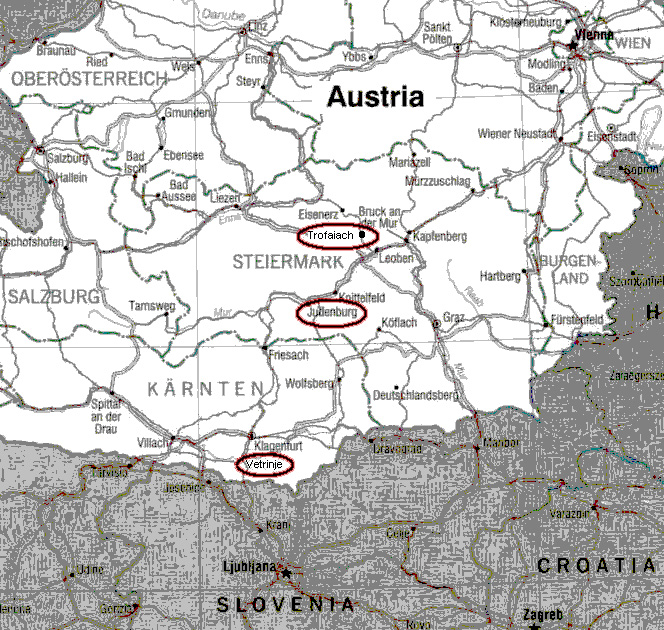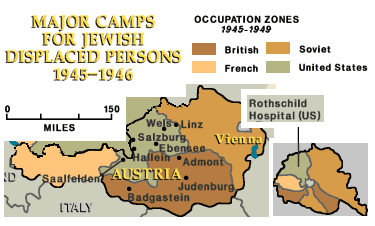Austrian
Research
120 camps in 1948,
some are listed here: 42,075 residents in 1947
20,174 residents in 1949
19,122 residents in 1950
If your camp isn't here, e-mail me and I'll add it.
And open thank you to Klaus Forhinger klaus.fohringer@aon.at and Herta M. for all the hard work they did helping me find the archives, city offices and updating these Austrian pages.
Click here to download to your desktop the 2011 Excel spreadsheet (in German) of camps and camp info: AustriaCampsV7.xls provided by Klaus.
Explanation of the used colour code:
- black: old entries till the current internet version V3
- red: new entries since version V3
- violet: other than DP camps (concentration, slave labour, Prisoners Of War)
- pink: still to verify
- grey: used after 1955 (end of the Austrian occupation)
Old version is in English: 2007 version Excel worksheet which Klaus
Fohringer provided which shows camps, regions, zones and proxity.
He did a lot of work for you. Take a look. It should download to your desktop. DPL
Osterreich2.xls
Austrian archives - https://www.oesta.gv.at
2/10/2017 Fachliche Interessen
Zur detaillierten geschichtlichen Aufarbeitung der damaligen Lager wurde eine fachliche "IG" im heutigen Oberösterreich gegründet.
Diese IG nimmt alle Anfragen zu allen Lagern des Zeitraumes 1934 - 1964 entgegen, sammelt Unterlagen zu allen Typen von Lagern und erteilt Auskünfte zu Themen, die ursächlich mit den damaligen Lagern in Verbindung stehen. Einschlägige Anfragen, aber auch Ablieferung von Dokumenten, Fotos und Akten können gerichtet werden an folgende Mailadresse:
m.weiss@jesus.ch
A Professional Interest Group (IG) was established for the story of the camps (baracks) in Upper Austria.
For a detailed historical reappraisal of the former camps, a professional Interest Group was founded in today's Upper Austria.
m.weiss@jesus.ch
The Kriegsarchiv
website - Karen Hob submitted 11/16/08
The Kriegsarchiv
website now has a number of PDFs that are the very ones I have used
in my conference presentations with a number of added charts. http://www.oesta.gv.at/
First click on Familienforschung, then click
on Kriegsarchiv
One, as an example, is an index of all the names mentioned in von Wrede's
history of the A-H army.
Most of the names will be officers but every here and there Wrede may have
mentioned a common soldier.
See and download the PDF at: https://www.oesta.gv.at
The main page where it is possible to select titles is at: https://www.oesta.gv.atThe items on the lower half of the page include the charts from von Wrede's books showing which regiments were recruited in Bohemia, Moravia, Hungary, Galicia and Bukowina up to about 1868 and others.
Click on all of the links under Forschungstipps / research tips.
A very good copy of the 1898 recruiting map (stayed pretty much the same up to 1914) is at: http://www.oesta.gv.at
Galicia: Registration sheets of officers who joined the Polish army in 1918.
Submitted
by Laurence Krupnak Lkrupnak@erols.com:
Most of the registration sheets of draftees from Galicia (Southern Poland, Western Ukraine) have been destroyed (Centralne Archivwum Wojskowe, PL-00910 Warszawa-Rembertów)
 12/19/04
Already at this point, it is fair to argue that many more primary sources have
been discovered in semi-archival deposits of banks and companies as well
as museums. Although these sources are in many cases highly fragmentary,
in total they constitute much more than what has previously been available
for historical research.
12/19/04
Already at this point, it is fair to argue that many more primary sources have
been discovered in semi-archival deposits of banks and companies as well
as museums. Although these sources are in many cases highly fragmentary,
in total they constitute much more than what has previously been available
for historical research. Archives that had been closed or had limited access in East Central Europe and Russia were found to contain material from the Nazi period. Due to general disinterest in thorough historical documentation combined with underlying fears of facing the "truth" with respect to the Nazi period, most of the banks and companies involved in the recent legal disputes rarely established professionally structured archives that also contained material from outside sources (such as the fragmentary collections of the Creditanstalt-Bankverein, which in the 1980s ended academic research started by Eduard März in 1973 and never approached a professional archival solution beyond the level of board meeting minutes. In the mid-1970s they destroyed a large collection of documents.
The former Oesterreichische Laenderbank's documentation is even more fragmentary, whereas the former Zentralsparkasse in Vienna, now part of the Bank Austria group, still has a large deposit of archival documentation
Other companies like the Voest Alpine Stahl AG in Linz forgot about the existence of the largest collection of documents that were stored in the cellar of a "Luftschutz" tower and contained more than 30,000 personnel records of forced labor and German workers. In comparison, like in most of the Austrian and German companies, the personnel records of the Volkswagen AG have been completely destroyed.
Alan Newark / United Kingdom


Austria, by
Colonel Charles J. Farinacci, MC (Ret.):
"The rapid collapse
of the German Army in Austria in May 1945 found the quadripartite powers
somewhat unprepared for the complex public health problems which confronted
them. In the first days of the occupation, the major task facing the
U.S. Army was that of halting, under conditions of extreme filth, malnutrition,
and starvation, the spread of serious communicabl e diseases by disease-infested
victims of Nazi oppression among a civilian population that was both
demoralized and confused.
Land Upper Austria and, to a lesser degree, Land Salzburg, in the spring and summer of 1945 were foci of such problems. In addition to the indigenous population....estimated at somewhat more than 1 million inhabitants, there were an estimated 700,000 displaced persons and refugees, including about 80,000 concentration camp inmates of five large camps, 200,000 displaced Austrian refugees, and 250,000 disarmed enemy forces (prisoners of war).
"The Four Power Declaration of 4 July 1945 stated that Austria had been restored to its 1937 (pre-Anschluss) frontiers; it was administratively divided into eight provinces and the city of Vienna. The same Allied agreement divided Austria into four occupation zones.
"The Soviet zone included (1) the province of Burgenland (which had a common frontier with Hungary), (2) the province of Lower Austria (Vienna, which lies within it, received quadripartite occupation), and (3) that part of the province of Upper Austria (M lviertel) which lies on the north bank of the Danube River and shares a common frontier with Czechoslovakia and a small part of West Germany.
"The U.S. zone consisted of (1) the province of Salzburg, and (2) that part of the province of Upper Austria lying on the south bank of the Danube River, both of which have common frontiers with West Germany.
"The French zone, bordering on Switzerland and Italy, consisted of the provinces of Tirol and Vorarlberg.." For more, see: http://history.amedd.army.mil
18.1.2023: Hello,
My name is Franziska Lamp and for my dissertation project at the University of Vienna, which is looking at migration policies in Austria after the Second World War (https://displacement-and-migration-regimes.univie.ac.at/), I am conducting narrative, oral history interviews on the life stories of former Displaced Persons (DPs) and refugees who spent parts of their lives in Austrian DP / refugee-camps after the end of World War II. If you have any information about experiences and memories of life in these camps or would like to give me an interview, please feel free to contact me under the following email:
franziska.lamp@univie.ac.at
Department of Contemporary History
University of Vienna
Spitalgasse 2-4, Hof 1
1090 Vienna
https://zeitgeschichte.univie.ac.at
Kind regards and thank you so much again for your help and for creating this great website!
Franziska Maria Lamp, BA BA MA
Wissenschaftliche Projektmitarbeiterin & Doktorandin/ PhD-Researcher
Institut für Zeitgeschichte/Department of Contemporary History
Universität Wien /University of Vienna
Spitalgasse 2-4, Hof 1
1090 Wien / Vienna
franziska.lamp@univie.ac.at
+43-1-4277-41219
https://zeitgeschichte.univie.ac.at
Project homepage: https://displacement-and-migration-regimes.univie.ac.at/
Recent Publications:
"The `unmarried mother': Single-mother families in displaced persons camps
in post-World War II Austria, in: Routed, Migration & (Im)mobility Magazine,
https://www.routedmagazine.com/unmarried-mother-wwii
"'…ob er mit seiner Eheschließung der Volksgemeinschaft nützt,'“ in:
Junges Forschungsnetzwerk Frauen- und Geschlechtergeschichte,
https://fernetzt.univie.ac.at/20211215-2/
DP camps information on Austria A-C